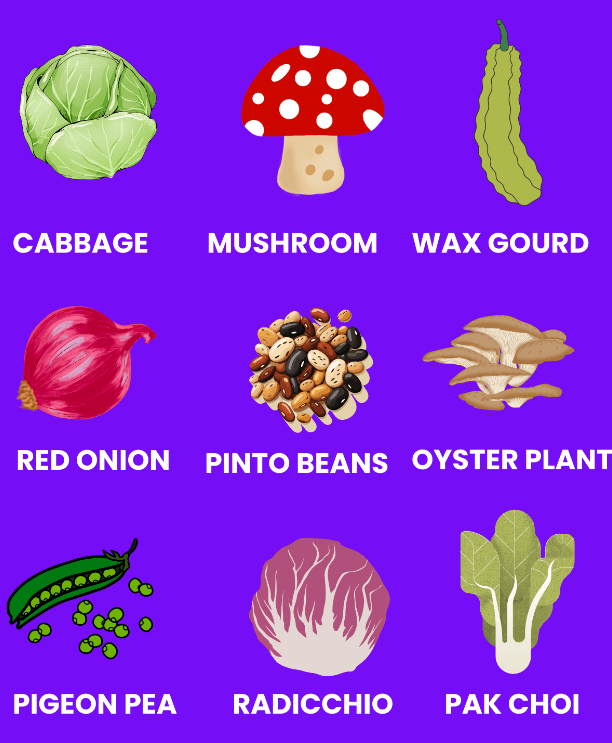Learning Spanish vegetable words helps you get more out of Spanish-speaking cultures, especially their food. Knowing these words lets you order food in restaurants, understand local dishes, and talk about food more efficiently. It also makes shopping at markets simpler because you can ask for exactly what you want. Plus, you can follow recipes and cook Spanish dishes yourself.
95 Vegetables in Spanish List
To better understand and enjoy Spanish food culture, learning some Spanish vegetable names is helpful. Here’s a simple list to get you started:
| No. | Spanish | English |
| 1 | Alcachofa | Artichoke |
| 2 | Apio | Celery |
| 3 | Berenjena | Eggplant |
| 4 | Brócoli | Broccoli |
| 5 | Calabacín | Zucchini |
| 6 | Calabaza | Pumpkin |
| 7 | Cebolla | Onion |
| 8 | Col | Cabbage |
| 9 | Col de Bruselas | Brussels sprout |
| 10 | Col rizada | Kale |
| 11 | Coliflor | Cauliflower |
| 12 | Espárrago | Asparagus |
| 13 | Espinaca | Spinach |
| 14 | Guisante | Pea |
| 15 | Haba | Broad bean |
| 16 | Judía verde | Green bean |
| 17 | Lechuga | Lettuce |
| 18 | Nabo | Turnip |
| 19 | Pepino | Cucumber |
| 20 | Pimiento | Bell pepper |
| 21 | Puerro | Leek |
| 22 | Rábano | Radish |
| 23 | Remolacha | Beet |
| 24 | Tomate | Tomato |
| 25 | Zanahoria | Carrot |
| 26 | Ajo | Garlic |
| 27 | Alcachofa de Jerusalén | Jerusalem artichoke |
| 28 | Alga | Seaweed |
| 29 | Apio nabo | Celeriac |
| 30 | Acelga | Swiss chard |
| 31 | Batata | Sweet potato |
| 32 | Boniato | Yam |
| 33 | Berro | Watercress |
| 34 | Calabacín amarillo | Yellow squash |
| 35 | Cardo | Cardoon |
| 36 | Champiñón | Mushroom |
| 37 | Chirivía | Parsnip |
| 38 | Endibia | Endive |
| 39 | Escarola | Escarole |
| 40 | Espárrago blanco | White asparagus |
| 41 | Frijol | Bean |
| 42 | Grelos | Turnip greens |
| 43 | Jícama | Jicama |
| 44 | Jitomate | Tomato (Mexican) |
| 45 | Kale | Kale |
| 46 | Lombarda | Red cabbage |
| 47 | Lenteja | Lentil |
| 48 | Mandioca | Cassava |
| 49 | Ñame | Yam |
| 50 | Okra | Okra |
| 51 | Patata | Potato |
| 52 | Pimiento morrón | Bell pepper |
| 53 | Pimiento picante | Hot pepper |
| 54 | Quimbombó | Okra |
| 55 | Rúcula | Arugula |
| 56 | Repollo | Cabbage |
| 57 | Setas | Mushrooms |
| 58 | Seta de cardo | Oyster mushroom |
| 59 | Soja | Soybean |
| 60 | Trigo | Wheat |
| 61 | Taro | Taro |
| 62 | Yuca | Cassava |
| 63 | Zapallo | Squash |
| 64 | Zanahoria morada | Purple carrot |
| 65 | Acelga roja | Red Swiss chard |
| 66 | Espinaca baby | Baby spinach |
| 67 | Puerro fino | Thin leek |
| 68 | Pimiento del piquillo | Piquillo pepper |
| 69 | Pimiento de padrón | Padrón pepper |
| 70 | Calabaza de invierno | Winter squash |
| 71 | Calabaza butternut | Butternut squash |
| 72 | Calabaza spaghetti | Spaghetti squash |
| 73 | Col china | Chinese cabbage |
| 74 | Col de napa | Napa cabbage |
| 75 | Col rizada lacinato | Lacinato kale |
| 76 | Judía morada | Purple bean |
| 77 | Judía amarilla | Yellow bean |
| 78 | Haba de Lima | Lima bean |
| 79 | Habichuela | Kidney bean |
| 80 | Habichuela negra | Black bean |
| 81 | Garbanzo | Chickpea |
| 82 | Lenteja roja | Red lentil |
| 83 | Lenteja verde | Green lentil |
| 84 | Lenteja marrón | Brown lentil |
| 85 | Pepinillo | Gherkin |
| 86 | Alcachofa bebé | Baby artichoke |
| 87 | Alubia | White bean |
| 88 | Guisante lágrima | Tear pea |
| 89 | Guisante verde | Green pea |
| 90 | Guisante amarillo | Yellow pea |
| 91 | Rábano picante | Horseradish |
| 92 | Ruibarbo | Rhubarb |
| 93 | Brócoli rabe | Broccoli rabe |
| 94 | Col romanesco | Romanesco |
| 95 | Puerro silvestre | Wild leek |
Effective Strategies for Learning Vegetable Names in Spanish
To get the hang of vegetable names in Spanish, it’s great to use visual aids and keep practising repeatedly. Try using flashcards, which you can either make yourself or find online. They help you remember better by linking pictures to words. You could also label the veggies in your kitchen with their names in Spanish. That’s a fun way to remember them.
Don’t forget to use apps or watch videos focusing on food vocabulary. They make learning exciting and help you remember things longer. Also, test yourself with quizzes and talk about veggies in Spanish whenever possible, maybe with friends who are also learning or native speakers. This practice makes your learning stick and helps you become fluent quickly.
Conclusion
Knowing 95 vegetable names in Spanish helps improve your language skills and understanding of the culture. This guide doesn’t just help you learn new words; it also connects you with Spanish-speaking communities through food. You can make this learning stick by using pictures and practising a lot. This way, you’ll get better at speaking Spanish and get into the culture in Spanish-speaking places.

